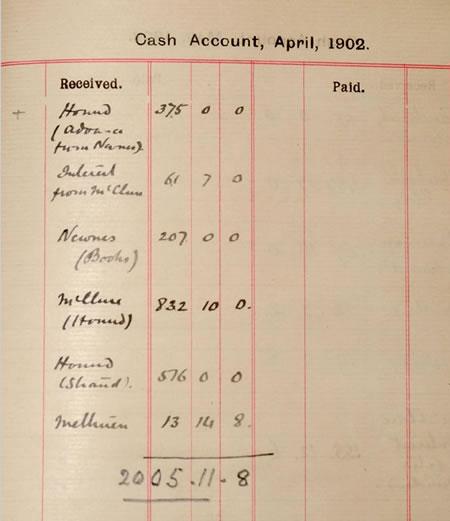The creator of Sherlock Holmes visited seances, was a close friend of escapologist Houdini and made a fortune from his most famous character.
Sir Arthur Conan Doyle was everything but elementary, a new exhibition of previously unseen material at the British Library reveals.
An account book from 1902 shows how in one month he earned over £2,000 in royalties for publishing "The Hound of the Baskervilles", his greatest Sherlock Holmes mystery, in American magazines. That is equivalent to hundreds of thousands of pounds today.
Another highlight is a telegram from Harry Houdini, wishing Conan Doyle and his wife a safe journey after visiting him in New York.
Despite several "vociferous" arguments over Conan Doyle's belief in spiritualist mediums, the two men were close friends, explains the library's co-curator of modern literary manuscripts Michelle Paull. Houdini exposed some mediums as scams, but Conan Doyle kept on believing in them even claiming that the master escapologist was in denial about being a medium himself.
The writer's diaries, in which he noted his dreams and appointments with seances, illustrate his passion for spiritualism. In one dream, he met Queen Victoria in St James's Park. She criticised him for not being courteous enough and told him to bow down and kiss her hand.
He kept newspaper clippings of disasters like earthquakes, suggesting that he may have seen them as omens.
The author also listed what he was reading, along with his verdicts of each work. About Shakespeare's Henry VI he remarked: "Much struck by his blunders. No doubt that first part of Henry VI is his earliest."
"The Narrative of John Smith", Conan Doyle's first unpublished novel about the reflections of a gout sufferer who is confined to his lodging room for six days, is put on view for the first time.
It is "not exactly a scintillating thriller", Paull reckons, but was probably based on Conan Doyle's earlier life as a doctor.
Conan Doyle claimed the manuscript had been lost in the post. Writing in 1897, he expressed relief: "I must in all honesty confess that my shock at its disappearance would be nothing as to my horror if it were suddenly to appear again.
"Had it appeared I should have probably awakened to find myself infamous, for it steered, as I remember it, perilously near to the libellous."
Researchers are still finding whether the manuscript resurfaced later, Paull says. Perhaps the author had it all along, but was "slightly embarrassed" at his first work.
However, Paull "quite enjoyed" the novel. "It gives a glimpse into the beginnings of the fame of Conan Doyle."
The manuscript was one of 900 documents received in a bequest from the writer's daughter, Dame Jean Conan Doyle, this year. The British Library bought another 1,200 documents in ten "significant" lots at auction last May.
One of the author's last Sherlock Holmes mysteries, "The Adventure of the Retired Colourman" (1926), is also on display.
A series of 800 letters he wrote to his mother, Mary Doyle, testifies to their close relationship. "The Mam", as he called her, set off his imagination with stories about his ancestors, Paull explains.
A wedding album includes photographs of Conan Doyle and his second wife, Jean Leckie, with whom he had three children. She adored her "darling beloved" husband, even taking up automatic writing in support of his spiritualist interests.
According to Paull, Conan Doyle was "a big family man". His first wife left two children when she died of tuberculosis.
- The display will run from today to January 31, 2005, in the Front Hall of the British Library at St Pancras. Admission is free.







Comments: Our rules
We want our comments to be a lively and valuable part of our community - a place where readers can debate and engage with the most important local issues. The ability to comment on our stories is a privilege, not a right, however, and that privilege may be withdrawn if it is abused or misused.
Please report any comments that break our rules.
Read the rules hereComments are closed on this article